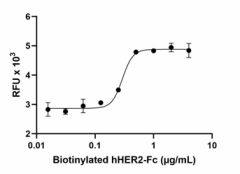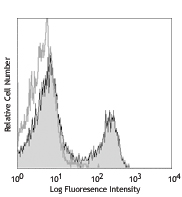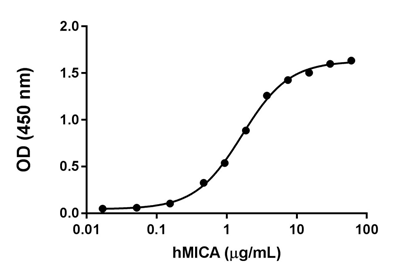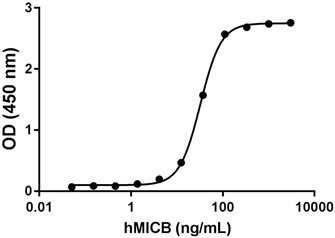- Regulatory Status
- RUO
- Other Names
- ErbB2, Neu, CD340, TKR1, Herstatin, Proto-Oncogene Neu, human epidermal growth factor receptor 2, Receptor Tyrosine-Protein Kinase ErbB-2.
- Ave. Rating
- Submit a Review
- Product Citations
- publications

-

Biotinylated recombinant human HER2-Fc counteracts the inhibition of SK-BR-3 cell proliferation in the presence of 0.12 µg/mL anti-human ErbB2/HER2 (clone 4D5-8, trastuzumab) antibody. The ED50 for this effect is 0.1 – 0.6 µg/mL. -

Stability Testing for Biotinylated Recombinant Human HER2-Fc Chimera. Biotinylated Recombinant Human HER2-Fc Chimera was aliquoted in PBS, pH 7.2 at 0.2 mg/mL and one aliquot was kept at 4°C (Control), and another was frozen and thawed four times (4x Freeze/Thaw). After this procedure, the samples were tested for their ability to counteract the inhibition of SK-BR-3 cell proliferation in the presence of 0.12 µg/mL anti-human ErbB2/HER2 (clone 4D5-8, trastuzumab) antibody. The ED50 for this effect is 0.1 – 0.6 µg/mL.
| Cat # | Size | Price | Save |
|---|---|---|---|
| 796504 | 25 µg | ¥45,580 | |
| 796506 | 100 µg | ¥125,970 |
ErbB2 (HER2) is a member of the ErbB family of receptor tyrosine kinases (RTKs). This family includes EGF receptor, ErbB2, ErbB3, and ErbB4. The protein tyrosine kinases (PTKs) catalyze the transfer of the γ-phosphoryl group of ATP to tyrosine. ErbB2 contains an extracellular domain of 617 amino acids, a transmembrane α-helix, and cytoplasmic domain of 570 amino acids that contains a tyrosine kinase domain and a carboxy-terminal regulatory sequence. The binding of EGF to EGFR and neuregulin to ErbB4 induces dimerization and subsequent activation of the tyrosine kinase domain and finally, autophosphorylation of the ErbB receptors. Ligands for ErbB2 have not been described. ErbB2 can homodimerize constitutively or form heterodimers with other ErbB receptors after their binding to related ligands. In addition, ErbB2 forms homodimers that are not ligand-dependent. ErbB2 mediates different downstream signaling pathways depending on its homodimerization or heterodimerization. The ErbB2 gene is amplified in 20% of the cases of invasive breast cancer and also overexpressed in gastric cancer. Herceptin (trastuzumab), a humanized antibody, has been used for the treatment of breast and gastric cancer. Genomic profiling of different types of tumors have shown amplification of ErbB2 in salivary, vaginal, bladder, endometrial, cervical, and colorectal cancer.
Product DetailsProduct Details
- Source
- Human HER2, amino acid (Gln24-Leu651) (Accession: NM_004448.2), with a C-terminal human IgG1 (Pro100-Lys330), and an Avi-tag, was expressed in CHO cells. Human HER2-Avi tag was site-specifically biotinylated by enzyme BirA.
- Molecular Mass
- The 891 amino acid recombinant protein has a predicted molecular mass of approximately 98.3 kD. The protein migrates at approximately 120 kD and 240 kD by SDS-PAGE in DTT-reduced and non-reduced conditions, respectively. The predicted N-terminal amino acid is Gln.
- Purity
- > 95%, as determined by Coomassie stained SDS-PAGE
- Formulation
- 0.22 µm filtered protein solution is in PBS pH 7.2.
- Endotoxin Level
- Less than 0.1 EU per µg cytokine as determined by the LAL method
- Concentration
- 25 µg size is bottled at 200 µg/mL. 100 µg size and larger sizes are lot-specific and bottled at the concentration indicated on the vial. To obtain lot-specific concentration and expiration, please enter the lot number in our Certificate of Analysis online tool.
- Storage & Handling
- Unopened vial can be stored between 2°C and 8°C for up to 2 weeks at -20°C for up to six months, or at -70°C or colder until the expiration date. For maximum results, quick spin vial prior to opening. The protein can be aliquoted and stored at -20°C or colder. Stock solutions can also be prepared at 50 - 100 µg/mL in appropriate sterile buffer, carrier protein such as 0.2 - 1% BSA or HSA can be added when preparing the stock solution. Aliquots can be stored between 2°C and 8°C for up to one week and stored at -20°C or colder for up to 3 months. Avoid repeated freeze/thaw cycles.
- Activity
- Human HER2 is measured by its ability to block anti-human ErbB2/HER2 (clone 4D5-8, trastuzumab) antibody inhibition of SK-BR-3 cell proliferation. The ED50 for this effect is 0.1 – 0.6 µg/mL.
- Application
-
Bioassay
- Application Notes
-
BioLegend carrier-free recombinant proteins provided in liquid format are shipped on blue-ice. Our comparison testing data indicates that when handled and stored as recommended, the liquid format has equal or better stability and shelf-life compared to commercially available lyophilized proteins after reconstitution. Our liquid proteins are validated in-house to maintain activity after shipping on blue ice and are backed by our <a href="https://www.biolegend.com/ordering#guaranteed" target="_blank">100% satisfaction guarantee</a>. If you have any concerns, contact us at <a href="mailto:tech@biolegend.com" target="_blank" title="Send email to tech@biolegend.com">tech@biolegend.com</a>.
- Product Citations
-
Antigen Details
- Structure
- Dimer
- Distribution
-
Many tissues, overexpressed in breast cancers and gastric cancer
- Function
- Cell development, proliferation, survival, and motility
- Interaction
- HER2 (ErbB2) forms dimers with EGFR, ErbB2, ErbB3, and ErbB4
- Ligand/Receptor
- No ligand is known for ErbB2
- Bioactivity
- Human HER2 blocks the activity of anti-human ErbB2/HER2 (clone 4D5-8, trastuzumab) antibody inhibition of SK-BR-3 cell proliferation.
- Cell Type
- Epithelial cells
- Biology Area
- Cancer Biomarkers, Cell Biology, Immuno-Oncology, Immunology
- Molecular Family
- CD Molecules, Soluble Receptors
- Antigen References
-
- Olayioye MA. 2001. Breast Cancer Res. 3:385.
- Cho HS, et al. 2003. Nature. 421: 756
- Garret TP, et al. 2003. Mol. Cell. 11: 495.
- Bublil EM, Yarden Y. 2007. COCEBI. 19:124.
- MA Lemmon. 2009. Exp. Cell. Res. 315:638.
- Mitri Z, et al. 2012. Chemother. Res. Pract. 2012:743193.
- Sawyer CL. 2019. Cell. 179: 8.
- Maddi H, et al. 2021. Cancer (Basel). 13:3540.
- Meric-Bernstam F, et al. 2019. Clin. Cancer Res. 25:2033.
- Gene ID
- 2064 View all products for this Gene ID
- UniProt
- View information about HER2 on UniProt.org


















Follow Us